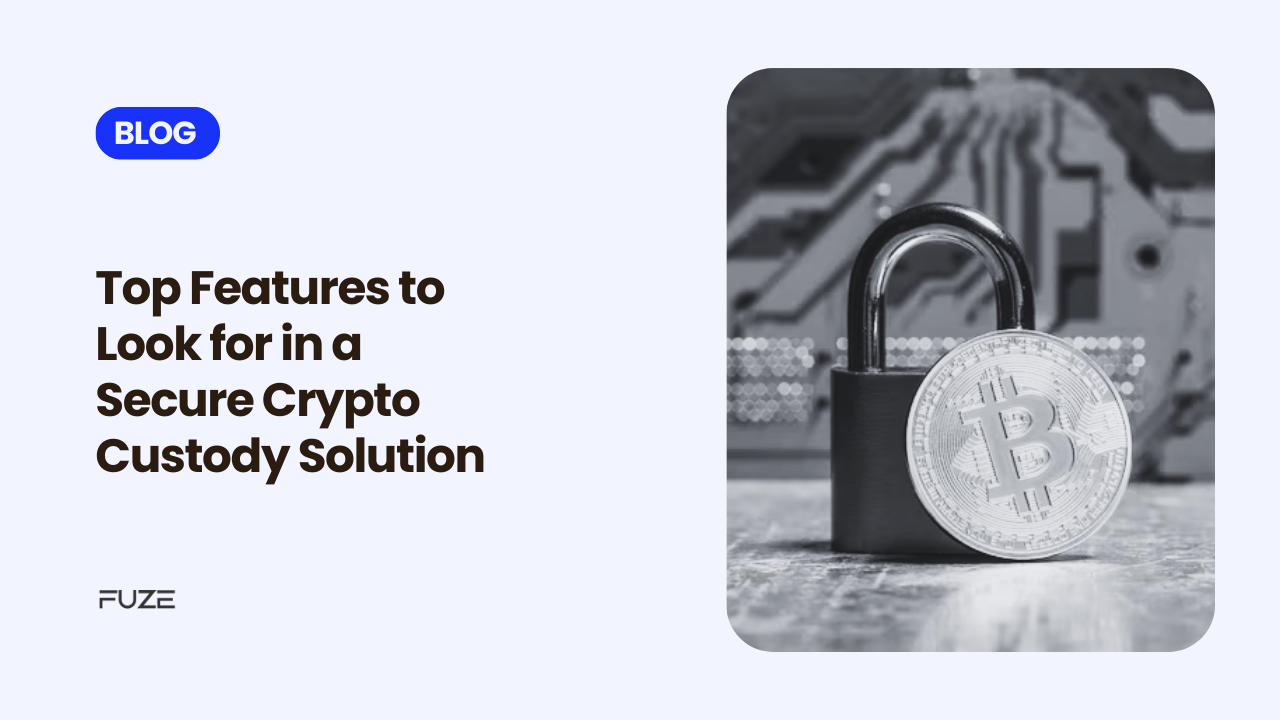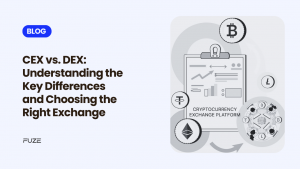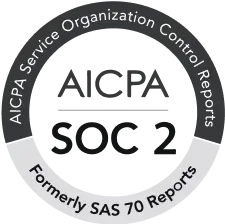The explosive growth of digital assets has created an urgent need for secure, efficient, and reliable custody solutions. Institutional investors, banks, hedge funds, and family offices are progressively investing in cryptocurrencies, highlighting the essential need to protect these digital assets. A strong custody solution not only shields assets from theft but also enables smooth operations, compliance, and growth.
This blog will explore the key features to consider when selecting a secure crypto custody solution, assisting institutions in making well-informed choices.
What Is a Crypto Custody Solution?
A crypto custody solution refers to a secure platform that is specifically created to store, manage, and safeguard digital assets for institutions and high-net-worth individuals. In contrast to conventional storage methods, these custody solutions provide enhanced security features, ensure regulatory compliance, and offer scalable infrastructure that caters to the requirements of institutional investors.
Here are the key features to Look for in a Secure Crypto Custody Solution:
- Advanced Security Protocols
Security is fundamental to any crypto custody solution. With more than $2.2 billion lost to crypto thefts in 2024 alone, the importance of advanced security measures cannot be emphasised enough. Look for solutions that incorporate:
- Multi-Party Computation (MPC): This technique divides private keys into several shares, which are then distributed across different locations, ensuring they never exist in a single form. This significantly reduces the risk of hacks or internal fraud.
- Multi-Signature (Multi-Sig): Multi-sig wallets require the approval of multiple parties for a transaction, providing an extra layer of security.
- Cold Storage: Keeping private keys offline greatly minimises exposure to online threats and hacks.
- End-to-End Encryption: This guarantees data protection throughout transactions and storage.
Why It Matters: Institutions handle vast amounts of digital assets, often in the billions. A security breach can lead to devastating financial losses and harm to reputation. Advanced security protocols serve as the first line of defence.
- Regulatory Compliance
Compliance is essential for institutions. A trustworthy custody solution must meet both international and regional regulatory standards. Key features to consider include:
- KYC/AML Integration: This ensures compliance with anti-money laundering and know-your-customer regulations.
- Certifications: ISO 27001 and SOC 2 Type II certifications demonstrate a custodian’s dedication to security and operational excellence.
- Regulatory Approvals: Custodians licensed in important jurisdictions (such as the UAE, Singapore, Europe, and the U.S.) offer additional assurance regarding their operations.
Why It Matters: Failing to comply with regulations can result in fines, sanctions, and a loss of trust. Selecting a compliant custodian guarantees that your operations are in line with legal requirements.
- Scalability and Flexibility
Institutions often need solutions that can expand alongside their requirements. Custody providers should deliver scalable infrastructure and adaptable solutions, which include:
- Support for Multiple Assets: Custody solutions must accommodate a diverse array of digital assets, ranging from Bitcoin and Ethereum to stablecoins and tokenised securities.
- Customisable Policies: Institutions should have the ability to establish tailored transaction limits, workflows, and access controls.
- API Integration: Smooth integration with trading platforms, payment gateways, and reporting systems is essential for operational efficiency.
Why It Matters: As the digital asset landscape continues to evolve, institutions require custody solutions that can adjust to new use cases, regulatory shifts, and client needs.
- Insurance Coverage
Insurance plays a vital role in risk management. When evaluating custody solutions, seek out those that provide extensive insurance policies that cover:
- Theft and Hacking: Safeguards against cyberattacks aimed at assets under custody.
- Operational Risks: Protection for losses resulting from internal mistakes or system failures.
- Third-Party Risks: Insurance for losses incurred due to actions of external vendors or partners.
Why It Matters: Having insurance adds an extra layer of security, helping to ensure financial recovery in the event of unforeseen circumstances.
- Institutional-Grade Performance
Institutions need solutions that provide exceptional reliability and performance. Key indicators include:
- High Uptime: Seek custodians with uptime levels above 99.99%, ensuring constant access to assets.
- Transaction Speed: Custody solutions must facilitate quick transaction processing, especially for high-frequency trading or liquidity provisioning.
- Robust Reporting Tools: Comprehensive audit trails, transaction histories, and compliance reports make portfolio management and regulatory filing easier.
Why It Matters: Downtime or sluggish transactions can lead to financial losses and operational inefficiencies, especially in volatile markets.
- User-Friendly Interface
Even the most secure and advanced custody solution should be easy to navigate. Features that improve usability include:
- Intuitive Dashboard: A centralised platform for tracking balances, managing transactions, and generating reports.
- Role-Based Access Controls: This feature allows institutions to set user roles and permissions, ensuring that only authorized personnel can access specific functions.
- Mobile Accessibility: Secure mobile applications provide real-time monitoring and transaction approval.
Why It Matters: A complicated or confusing interface can result in errors, inefficiencies, and frustration among users, which can negatively affect overall operations.
- Strong Governance Mechanisms
Effective governance features are essential for ensuring accountability and reducing internal risks. Consider the following:
- Transaction Approval Policies: Implementing multi-level approval processes for significant transactions provides an additional layer of oversight.
- Activity Logs: Maintaining detailed logs of all actions taken within the platform supports accountability and facilitates auditing.
- Separation of Duties: Distributing responsibilities among team members helps mitigate the risk of insider threats.
Why It Matters: Robust governance mechanisms strengthen internal controls and lower the chances of errors or fraudulent activities.
- Integration with DeFi and Web3
The growth of decentralised finance (DeFi) and Web3 applications necessitates that custody solutions adapt to these new environments. Key features to consider include:
- DeFi Staking and Yield Services: Provide secure access to DeFi platforms for activities like staking or lending.
- NFT Custody: Offer support for non-fungible tokens (NFTs) as they increasingly become a key component of institutional portfolios.
- Web3 Wallet Compatibility: Ensure smooth interactions with decentralised applications (dApps).
Why It Matters: Institutions must keep pace with market trends and seize new opportunities in the rapidly changing crypto landscape.
- Disaster Recovery and Business Continuity
Being prepared for unexpected events is crucial. An effective custody solution should encompass:
- Backup Systems: Consistently updated backups kept in various geographic locations.
- Disaster Recovery Plans: Detailed strategies to resume operations following cyberattacks, natural disasters, or system failures.
- 24/7 Support: Continuous technical and operational assistance to resolve issues quickly.
Why It Matters: A solid disaster recovery plan minimises operational disruptions, protecting both assets and client confidence.
- Cost Efficiency
While security and reliability are crucial, cost considerations also come into play. Consider the following:
- Transparent Fee Structures: Seek custodians that offer clear and predictable pricing models.
- Cost Savings from Integration: Custody solutions that work seamlessly with trading platforms and other systems can help lower overall operational costs.
- Economies of Scale: Institutions managing large portfolios might benefit from volume-based pricing or discounts.
Why It Matters: Cost efficiency has a direct effect on an institution’s financial performance, making it vital to find a balance between security and affordability.
Conclusion
As more institutions embrace digital assets, the need for strong and secure custody solutions has become increasingly vital. With billions of dollars in digital assets managed by institutions around the globe, protecting these assets is a strategic necessity. Trustworthy custody platforms are essential in connecting traditional finance with the fast-evolving crypto landscape.
Institutions seek platforms that offer not only top-notch security but also ensure compliance with international regulations and provide seamless scalability, improving operational efficiency. As the market continues to develop, institutions that invest in the appropriate custody infrastructure will be better prepared to manage risks, promote adoption, and excel in this transformative financial era.
Disclaimer: Virtual assets carry significant risks, including high volatility and potential loss of your entire investment. They are not backed by governmental protections, and recourse may be limited in case of loss. Always assess your risk tolerance, fully understand the risks, and seek independent financial advice if needed before investing.
Frequently Asked Questions
- What makes a custody solution user-friendly?
User-friendly solutions feature intuitive dashboards, role-based access controls, and mobile accessibility. These ensure seamless navigation and efficient transaction management, reducing errors and improving user satisfaction. - How do custody solutions integrate with DeFi and Web3 ecosystems?
Top custody providers offer compatibility with DeFi protocols, NFT custody, staking services, and Web3 wallets. This enables institutions to securely participate in emerging decentralised finance opportunities. - What governance mechanisms are vital in a custody solution?
Effective governance mechanisms include transaction approval policies, activity logs, and separation of duties. These ensure accountability, reduce insider threats, and enhance overall operational transparency. - What should institutions consider in terms of disaster recovery?
Institutions should look for custody solutions with robust disaster recovery plans, including geographically distributed backups, real-time failover systems, and 24/7 support to minimise operational disruptions. - How do cost considerations play a role in choosing a custody solution?
Institutions should evaluate transparent pricing models, operational cost savings through integrations, and potential discounts for large portfolios. Balancing cost efficiency with robust security is crucial for long-term profitability.







